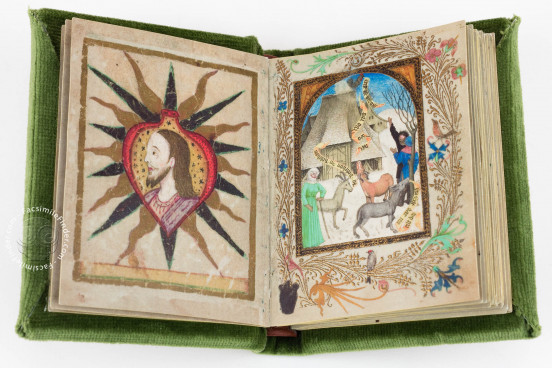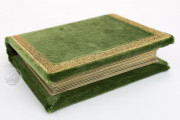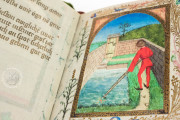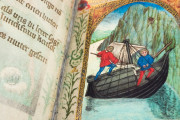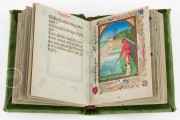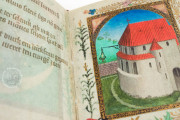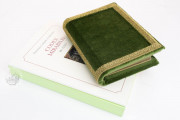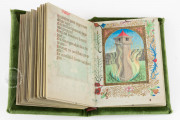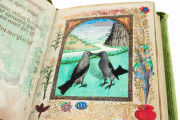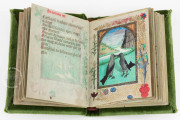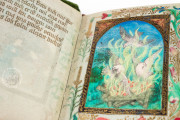Made in Cologne around 1470, the Dublin Wondrous Occurrences manuscript is a picture book of Christian exempla (moral anecdotes). Its text, in German rhyming verse, is based on a treatise on the Immaculate Conception of the Virgin Mary by the Dominican Franciscus de Retza. Each exemplum, totaling thirty-seven, is presented in a full-page image, followed by the corresponding text on the next page. The anecdotes were intended to defend the concept that the Virgin Mary was conceived without the stain of the original sin of Adam and Eve.
Illuminating Unbelievable Occurrences
Glittering golden decoration frames the beautiful, almost romantic pictures of a hitherto anonymous fifteenth-century German artist, images created to prove the existence of inconceivable things: birds that grow on trees, water that a virgin can carry in a sieve, as well as other, better known myths like the phoenix rising from the ashes, Circe turning humans into animals, or the lion who brings his cubs to life with a roar.
All that just to prove that Mary's virginity is part of a series of unbelievable but true occurrences. The author of the text, a Dominican monk in Vienna named Franz von Retz (1343–1427), created a particular form of late medieval typology and emblemology, which due to its vividness could only be transposed and explained in painting.
Seventy-four Pages of Late Medieval Imagination in Commented Images
This delicate German manuscript from Dublin, a marvellous picture book of the Defensorium inviolatae perpetuaequae virginitatis castissimae genetricis beatae Mariae makes the impossible possible and also credible for the contemporary reader. Thirty-seven leaves are decorated with delicate full-page miniatures on the recto, complete with short verses of an emblematic nature in German and Latin on the recto. These gold-heightened visual gems of illumination are juxtaposed with explanatory texts of a fifteenth-century Dominican pater.
The reasoning in picture and text follows a particular logic. If the gods of pagan antiquity are thought to have worked miracles, how much more credible are the miracles of the Christian world? How can anyone possibly doubt Mary's virginity? If it is true that in Cappadocia mares are impregnated by the wind, then the Lord's maid may also have conceived as a virgin. If Jupiter made Danae pregnant by a golden rain, then no one can doubt that Mary had a virgin birth. If in a temple of Venus the oil lamp never goes out, this is a sure sign of Mary's eternal virginity.
Enchanting Miniatures of the Cologne School
The miniatures were painted in an enchanting style by an unknown artist who obviously took particular joy in this unusual text. He loves genre painting and dealing with antique figures that he outfits, however, with the clothing and appearance of his own day. This painter, who was probably based in Cologne, is clearly marked by the school of Stefan Lochner. Impressive interiors and atmospheric landscapes of a refreshing colorfulness are distinguishing features of his style, as is the love for details, which requires calm and patient contemplation by the viewer. It is truly amazing how well he manages to illustrate the inconceivable.
The provenance from Cologne is furthermore underpinned by the marginal decoration: it shows the golden panicles so typical of the Cathedral city on the Rhine, twigs and foliage of gold, thickly applied to the parchment, with exquisite flowers in delicate colors. This painted manuscript and its text by Franz von Retz, which also circulated in the form of illustrated incunabula, is datable to the middle of the fifteenth century, around 1460.
We have 1 facsimile edition of the manuscript "Dublin Wondrous Occurrences": Von Wundersamen Begebenheiten facsimile edition, published by Mueller & Schindler, 2007
Request Info / Price
